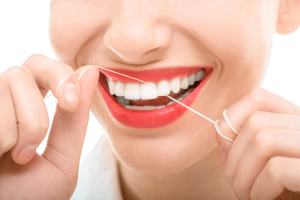Flossing is an important practice to maintain good oral health, but it often gets overlooked. We know it’s an easy step to forgo, especially if you’ve had a long day and you’re ready to go to bed. For most people, mornings are fast and furious. You’re lucky to get your teeth brushed and clothes ironed, much less flossed, before running out the door for a full day.
But the sooner you can implement this important step, the sooner your teeth will thank you. At Docklands Dental Studio, we see patients that floss frequently, but unfortunately, have caused damage by doing it incorrectly. There is a right way and a wrong way to floss your teeth, which is why we’ve put together some quick tips, techniques, and recommended tools to help protect your teeth and long-term oral health.
If you have avoided flossing, it’s probably a good idea to have your teeth professionally cleaned as soon as possible. Call our Docklands dental office today at (03) 9021-9487 to schedule an appointment with one of our doctors.
Recommended Techniques and Tools for Flossing
- String Floss: This is the most effective and traditional form of flossing. To make sure you are flossing correctly, be sure and carefully read through the steps outlined below. With string floss, it’s easy to create unnecessary gum sensitivity or bleeding by flossing too hard.
- Floss Picks: As one of the newer tools on the market, floss picks provide an easier, hassle-free approach to flossing. Similar in style to a toothpick, but with a strand of floss at the opposite end, they are easy to carry with you throughout the day to floss as needed. Pay careful attention to how hard you are pressing when inserting them between your teeth and gums. It’s easy to floss too hard with floss picks, which can lead to bleeding and gum sensitivity.
- Water Flosser: This flossing tool provides many benefits for patients, especially if you have a tendency to floss too hard. A water flosser uses high water pressure to remove plaque and food particles inside and on top of teeth. It allows patients to clean more deeply into gum pockets without damaging gum tissue, reducing your chances for gingivitis and gum disease. Patients with wire braces who struggle to floss with string floss find this tool very beneficial.
Correct Way to Floss
To help you implement this healthy habit, get started by setting an appointment reminder on your phone. As you follow through on those reminders, before you know it you will become a part of your every day oral healthcare regimen. Below are some steps to help make sure you are flossing correctly:
- Step 1: Take about 18 inches of floss and evenly wind around both middle fingers until your hands are approximately five inches a part.
- Step 2: Holding the floss tightly between your thumbs and forefingers, begin gently inserting it between the teeth, one tooth at a time.
- Step 3: As you insert the floss between your teeth, be sure to curve the floss in a “C” shape alongside the tooth.
- Step 4: With the same amount of pressure, carefully move the floss up and down to thoroughly remove bacteria and food particles between teeth. Avoid going too fast or pressing too hard. If you notice any blood, you may be flossing too hard.
- Step 5: Repeat the steps for each tooth, making sure to reach behind your back molars where food and bacteria tend to get trapped.
Schedule Your Checkup Today
To help prevent further tooth decay from developing, schedule your checkup and cleaning with one of our trusted doctors. Give us a call at our Docklands dental office today at (03) 9021-9487.

